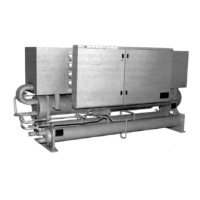68 Product Manual WHR-2
Design Limitations
1. Maximum allowable condenser water pressure is 225 psig (1550 kPa).
2. Maximum allowable evaporator water pressure is 175 psig (1206 kPa).
3. Maximum design saturated discharge temperature (SDT) is 140°F (60°C). SDT=Condensing
temperature + discharge line loss.
4. Maximum allowable water temperature to evaporator in a non-operating cycling is 100°F
(37.8°C). Maximum entering water temperature for operating cycle is 90°F (32.2°C) (during
system changeover from heating to cooling cycle). An optional return water unloading
thermostat is required for return temperatures greater than 75°F (23.4°C).
5. Minimum design leaving water temperature from the evaporator without freeze protection is
42°F (6°C).
6. Contact your McQuay representative for operation with tower condenser water entering the
chiller below 70°F (21.1°C).
7. Compressor unloading is not allowed with leaving chilled fluid temperatures 35°F or less.
8. The optional Microtech control is required for ice storage applications.
9. The maximum altitude for air-cooled condensers is 6,000 feet.
10. Consult factory for ambient operation below 0°F (-17.8°C).
Remote Condenser Refrigerant Piping
General
Careful design of refrigerant piping is necessary for proper system operation. The refrigerant
piping should be designed to accomplish the following:
1. Assure proper refrigerant feed to the evaporator.
2. Provide practical and economical refrigerant line sizes without excess pressure drop.
3. Maintain uniform oil return to the compressor under all load conditions.
4. Refer to the latest version of the ASHRAE Handbook for recommended piping practice.
Limit the length of refrigerant piping by locating the condenser as close to the chiller as possible.
Avoid all unnecessary changes in direction or elevation. On dual circuit units, the condensers must
be selected with separate condenser sections so that the circuits are not combined and precautions
taken to avoid cross-connecting the circuits.
Liquid Line
Where there is a vertical lift from the condenser to the chiller, adequate subcooling must be
provided to prevent liquid flashing before the expansion valve. A shutoff valve should be installed
in the liquid line to allow isolation of the remote condenser.
Discharge line
The discharge line should be trapped at the compressor and looped at the condenser (inverted trap)
to prevent liquid refrigerant from draining back onto the compressor heads. Pressure drop should
be held at a minimum.

